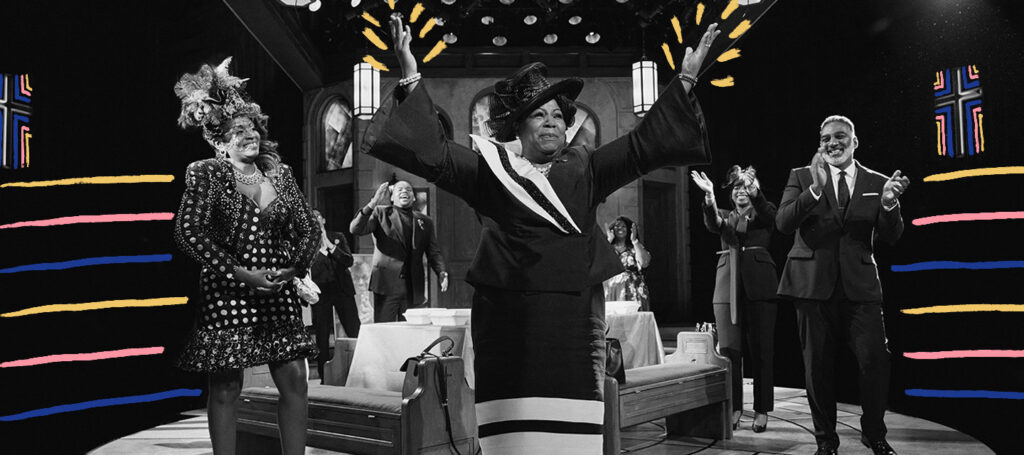


‘Chicken & Biscuits’: How Do You Critique a Laugh?
Chicken & Biscuits by Douglas Lyons seems to have a seat at the unapologetically Black table, and an invitation to the cookout for its token white-presenting character (we’ll get to that later). Entering the show my mouth watered at the idea of a tasty meal, instead I was served microwaved soul food.
If you’re wondering how the title came to be, or how the show made its way from DMs to Broadway— which are important points to touch on, Chicken & Biscuits is what it is, providing us with laughter and tears as only a Black situational comedy could. Which led me to wonder: how do you critique a laugh?
A family comes to church in New Haven, CT for the funeral of their beloved father and grandfather. We are introduced to sisters first lady Beneatta Mabry (Cleo King) and hot Atlanta hairdresser Beverly Jenkins (Ebony Marshall-Oliver) daughters of the late pastor Bernard Jenkins. Reginald Mabry (Norm Lewis) Beneatta’s husband, Simone Mabry (Alana Raquel Bowers) and Kenny Mabry (Devere Rogers) children of Beneatta and Reginald, La’Trice Franklin (Aigner Mizzelle) daughter of Beverly, and Logan Liebowitz (Michael Urie) – the white token character – Kenny’s plus one.
Lyons sticks to George Bernard Shaw’s rule that “If you want to tell people the truth, make them laugh, otherwise they’ll kill you.” In typical sitcom plot development, when things get tough emotionally, out of the bag pops a cultural reference showcasing tropes of the Black experience.
Often these references provide a laugh to ease the discomfort before reaching for the breakthrough of hard truths. We are pummeled into laughing submission, unable to question in real time what we are laughing at, and more importantly whom. Because the characters don’t dispute what is said about Black culture, Chicken and Biscuits leaves an aftertaste that will reinforce falsehoods for observers.
For instance, the deconstruction of the Black man is a subtle narrative that continues to spew out from the stage as we laugh. Raggedy daddy, closeted, disloyal, cheater, shaky impersonator, and a sin. These are one-sided snippets from a singular perspective and the impact reinforces superficial uninformed stereotypes.
Questioning this tactic of self deprecating exposition does not negate the reality, or the character’s feelings about their lived experience, but points to the superficial messages that observers leave holding when walking in the real world. The play also touches on the clichés assigned to interracial relationships when one of the Black female characters is dumped for a Becky.
White culture has reinforced myths about Black men which make them unlovable and unable to love themselves. We need an evolution of self love as much as a good laugh.
There’s also the cringe-worthy way in which white men, despite their religious upbringing (“I’m a Jew!” exclaims Logan at one point) communicate an assumed shared understanding of oppression and discrimination to other themselves from white-presenting people. What is laughable is his tokenism, reflecting years of Black men and people of color serving as singular stock characters in white plays. Therefore Logan is nothing but a tool.
The saving grace of this production is the direction by Zhailon Levingston and his collaboration with the actors and designers.
It is noteworthy that the entire design team identifies as Black, an unusual reality in productions, especially when the story being told is about Black lives. Yet, this feat is more a commentary on the industry, not this individual production.
The design team is a cohesive unit that grounds the action giving us a foundation to see the characters’ journeys with more clarity. Dede Ayite (Costume Designer) and Nikiya Mathis (Wig, Hair and Makeup Design) have a special gift for subtle detail. The characters’ backstories are conveyed through pieces like Basquiat Doc Martens with yellow and green shoe-laces, black and green press-on nails with a red ring, blue waterfall hair with finger waves, hair pressed and styled for the gods, Afrocentric coat lining, African embroidery on the pastor’s robe, and asymmetrical church hats.
Lawrence E. Moten III (Scenic Design) creates both a visual and visceral environment welcoming audience members to be witnesses, eventually rearranging set pieces inviting us to participate as the congregation. Twi McCallum’s evocative sound design heightens the sitcom aspects of the play.
While the stylistic choice of honeycomb lamps hanging in the church is questionable, Adam Honore (Lighting Design) dazzles us with warm colors that evoke intimacy and bring out the inner light of each member of the congregation. As the lights grow brighter, so do we in spirit and thought. The stage is lit with love.
Either dim brilliance or bright desperation, Chicken & Biscuits is a teleplay with trending catchphrases (“Okrrr!”) and jokes that make fun of the audience laughing at them. How Black people apologize for or hide their pain, taught not to cry or speak about what’s bothering them, or to rely on laughter to avoid pain for others’ comfort is something Lyons captures.
What left a bad taste in my mouth does not negate the gift that Lyons has for writing what might not be a play, but rather a performance of Black culture for white audiences. If Chicken & Biscuits is a social commentary on how Black productions and Black people shape themselves to fit into white spaces like Broadway, everyone is welcome to the repass.
Keep Reading

In ‘Lackawanna Blues’ Santiago-Hudson Builds a Memorial for the Forgotten
In 1983, in In Search of Our Mothers’ Gardens, Alice Walker, wrote: “We are a people. A people do not throw their geniuses away. And if they are thrown away, it is our duty as artists and as witnesses for the future to collect them again for the sake of our children, and, if necessary, […]
Read More
‘Six’: They Run This Mutha (Yeah!)
Remember the first time you saw your favorite artist in concert? The tingling sensation that took over your body, the thrill of being in community with strangers, the expectation that your favorite songs will be performed. Going to Six feels exactly like that. Except, this time the artists in question have been brought back from […]
Read More












